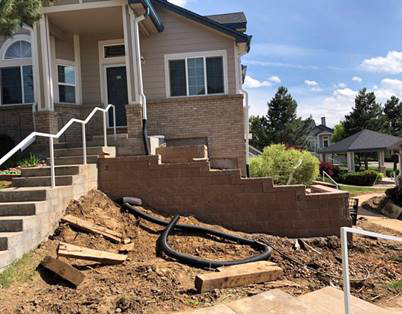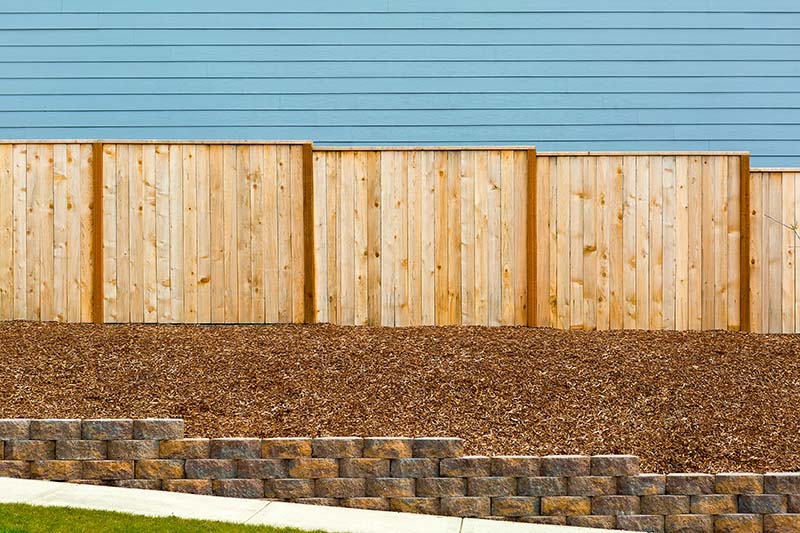Drainage solutions to make your OKC Precision Retaining Walls last longer
Trick Factors To Consider for Building Efficient Retaining Walls in Your Yard
When you're considering constructing a preserving wall in your backyard, it's crucial to believe concerning a number of vital variables. The wall's function, the products you'll utilize, and the certain dirt conditions can all affect its efficiency and longevity.
Recognizing the Purpose of Your Retaining Wall
When you consider building a preserving wall surface, consider its primary function: maintaining dirt and preventing disintegration. Retaining walls supply necessary support for sloped landscapes, helping to maintain soil honesty. You'll find they're important in areas where water drainage might or else clean away dirt, bring about pricey repairs and landscape damage.
By keeping back planet, these walls develop degree surface areas for yards, outdoor patios, or paths. This not just enhances your backyard's visual appeals but additionally advertises much better drain, decreasing water merging in unwanted locations. If you're managing steep inclines, a sound retaining wall surface can avoid landslides, ensuring security for you and your home.
Inevitably, recognizing the objective of your retaining wall will certainly lead your style choices and aid you develop a practical, sturdy framework that fulfills your needs. So, take a minute to review your landscape; it'll settle over time.
Picking the Right Materials
When choosing products for your retaining wall surface, you'll want to consider durability, visual appeals, and price. Each factor plays a vital duty in guaranteeing your wall stands the examination of time while looking terrific and suitable your budget plan. Allow's discover exactly how to make the finest options for your job.
Material Resilience Factors
Picking the best materials is essential for the durability and performance of your retaining wall surface, because their sturdiness straight influences the wall surface's ability to hold up against environmental anxieties. Start by considering your local climate; products like concrete and stone withstand dampness and temperature level variations well. If you reside in a location vulnerable to heavy rainfalls, choose for products with excellent water drainage buildings, like crushed rock or porous blocks, to stop water build-up.
Furthermore, believe concerning the dirt problems on your property. Some products carry out better in certain soil kinds, so it's vital to match them as necessary. Finally, be conscious of potential wear from insects or erosion. Selecting sturdy materials assurances your retaining wall stands strong, shielding your yard for many years to find.
Aesthetic Layout Choices
Long lasting materials not only guarantee your retaining wall surface's structural stability yet also play a vital function in its visual appeal. Do not neglect concerning the wall's shape-- bent walls can develop a softer appearance, while straight lines can really feel extra organized. By meticulously selecting products that line up with your visual vision, you'll enhance your exterior space while ensuring your wall surface stands strong versus the components.
Cost-Effectiveness Evaluation
Picking the best materials for your retaining wall surface isn't practically appearances; it's likewise crucial for your budget. When choosing materials, consider both ahead of time expenses and lasting toughness. Concrete blocks may be costlier originally, however their long life can conserve you cash on repair services. On the other hand, lumber can be much more budget-friendly however may call for substitute sooner.
Don't fail to remember to aspect in maintenance prices. Some materials, like natural stone, can add charm and call for less upkeep, while others may need routine therapies
Eventually, evaluate the benefits and drawbacks of each alternative versus your budget plan and the wall's desired function. Investing wisely in products now can prevent costly concerns in the future. Choose products that stabilize cost and performance effectively.
Evaluating Soil Conditions and Water Drainage
As you begin your job, examining soil conditions and water drainage is vital for the success of your retaining wall. Beginning by analyzing the type of soil in your yard. Sandy soil drains well but does not have security, while clay dirt can preserve dampness, leading to press on your wall surface. Evaluate the dirt's wetness content by digging a small opening and observing exactly how swiftly it dries out.
Following, examine the incline of your yard. If water naturally streams toward your wall, you'll require to implement a drain remedy to avoid disintegration and pressure accumulation. Think about mounting perforated pipes or gravel backfill behind the wall to facilitate water drainage.
Lastly, observe any kind of neighboring trees or vegetation; their origins can influence soil security. By recognizing your dirt conditions and executing correct drainage, you'll produce a solid structure for your retaining wall surface that stands the examination of time.
Abiding By Local Structure Codes
Before you start constructing your retaining wall surface, you need to research local guidelines to assure conformity. It's necessary to understand what allows you should get, as this can save you from costly penalties or needing to remodel your work. Taking these steps seriously will help you build a risk-free and reliable framework.
Research Local Laws
Recognizing local policies is crucial when planning your retaining wall project, more specifically because constructing codes can vary considerably by area. Start by getting in touch with your local structure division or town to learn regarding specific needs. Search for guidelines on wall elevation, materials, water drainage systems, and architectural stability. Many areas have restrictions on the types of materials you can utilize and how high you can build. You'll additionally intend to take into consideration the zoning laws that may impact your project. Overlooking these regulations can result in expensive fines or the need to redo your work. By doing your research study upfront, you can assure your retaining wall surface meets all needed codes and blends seamlessly right into your backyard.
Obtain Necessary Licenses
Once you've looked into neighborhood regulations, the next step is to get the essential authorizations for your retaining wall surface project. This procedure assurances your wall surface abides by building ordinance and safety requirements. Get to out to your local structure authority to learn what allows you require. They might call for particular strategies or engineering analyses, especially for bigger walls. Be prepared to send detailed illustrations, including measurements and materials. Do not forget to inspect if your project affects drainage or neighboring residential properties, as these aspects might need added authorizations. Protecting the right authorizations can conserve you from pricey fines or needing to dismantle your wall later. Remember, following the regulations currently will certainly lead to a smoother building experience.

Planning the Design and Aesthetic Appeal
As you begin planning the style and appearances of your retaining wall surface, think about how it will harmonize with the bordering landscape. Think regarding the materials you'll utilize-- stone, brick, or concrete-- and how they'll enhance your home's style and the natural environments in your backyard. Pick shades and appearances that mix flawlessly with existing features like patios, paths, or gardens.
Next, picture the wall's form and height. Rounded walls can soften an inflexible landscape, while straight lines might share a more contemporary look. Do not fail to remember to integrate plants and plant around the wall for an all-natural touch; this can improve its charm and incorporate it into the setting.
Last but not least, remember performance. Your style should not just be visually pleasing yet likewise offer its purpose successfully. By attentively intending these aspects, you'll produce a preserving wall surface that boosts your backyard's elegance while satisfying its architectural function.
Computing Elevation and Thickness Needs
To construct a strong retaining wall surface, you need to properly compute its elevation and density demands based upon the soil conditions and the height of the incline it will support. Beginning by evaluating the incline's angle and the kind of dirt, as various dirts apply differing quantities of stress.
For walls over four feet high, take into consideration a density of at least 12 inches. If the wall surface is taller, boost the density proportionally to maintain security.
Following, calculate the elevation of the wall surface by measuring the upright distance it requires to preserve. For every single foot of height, you should typically prepare for a thickness of one-third of the wall surface's height.
Constantly remember to represent additional aspects like water drainage and backfill, which can affect your straight from the source wall's layout. Correct calculations currently ensure your retaining wall surface stands strong and lasts for years to find.
Maintenance and Durability Factors To Consider
While maintaining your retaining wall surface may feel like a low top priority, disregarding it can lead to substantial issues with time. Routine examinations are crucial; check for fractures, bulges, or any kind of indications of water damage. Attending to these issues early can conserve you from expensive fixings in the future.
Watch on water drainage systems, also. Obstructed drains can trigger water to build up, exerting stress on your wall surface and endangering its security. Clear debris and warranty correct circulation to preserve longevity.
You may additionally intend to review securing your wall to protect it from dampness and weathering. Relying on the material, this could call for reapplication every couple of years.
Finally, landscape design around your wall can support its stability. Prevent growing large trees nearby, as their roots can weaken the foundation. With positive upkeep, your retaining wall surface you could look here can offer you well for years to come.

Frequently Asked Inquiries
Can I Develop a Retaining Wall by Myself, or Should I Hire an Expert?
You can definitely construct a maintaining wall surface yourself if you have the right tools and knowledge. However, employing a specialist assurances it's done appropriately, especially for larger or more complex structures. Consider your ability level before making a decision.
What Are one of the most Usual Mistakes Made When Building Retaining Walls?
When constructing retaining walls, you might neglect proper water drainage, skip utilizing the ideal materials, or disregard support. These usual errors can cause architectural failing, so take your time and strategy thoroughly to avoid problems.
Just how Do I Know if My Retaining Wall Needs Support?
You'll know your retaining wall requires support if you notice fractures, leaning, or protruding. Check for water merging behind it or soil erosion near the base. Address these signs quickly to stop further damages.
What Plant kingdom Appropriate for Landscaping Around a Retaining Wall?
When landscaping around a maintaining wall, take into consideration using low-maintenance plants like succulents, ornamental grasses, or sneaking ground covers - OKC Precision Retaining Walls. They'll grow in those conditions and include elegance while avoiding dirt erosion around your wall
Just How Can I Prevent Disintegration Around My Retaining Wall?
To avoid disintegration around your retaining wall surface, you can grow ground cover, usage mulch, and mount drain systems. Consistently examine for water accumulation and readjust landscape design to reroute runoff away from the wall.